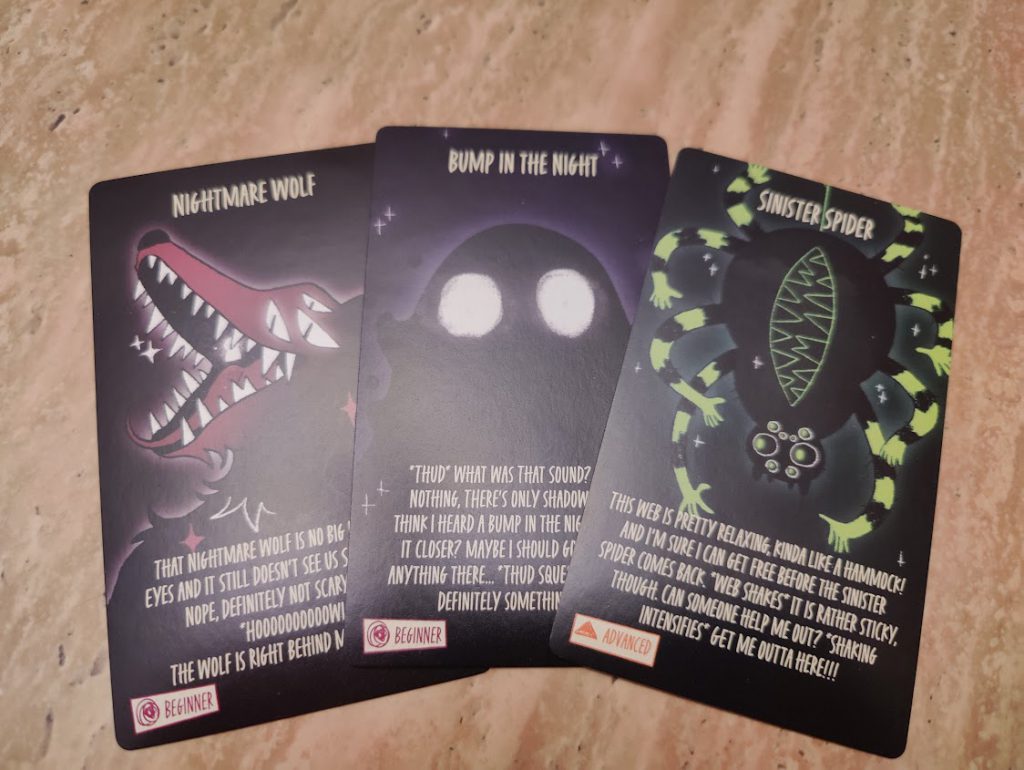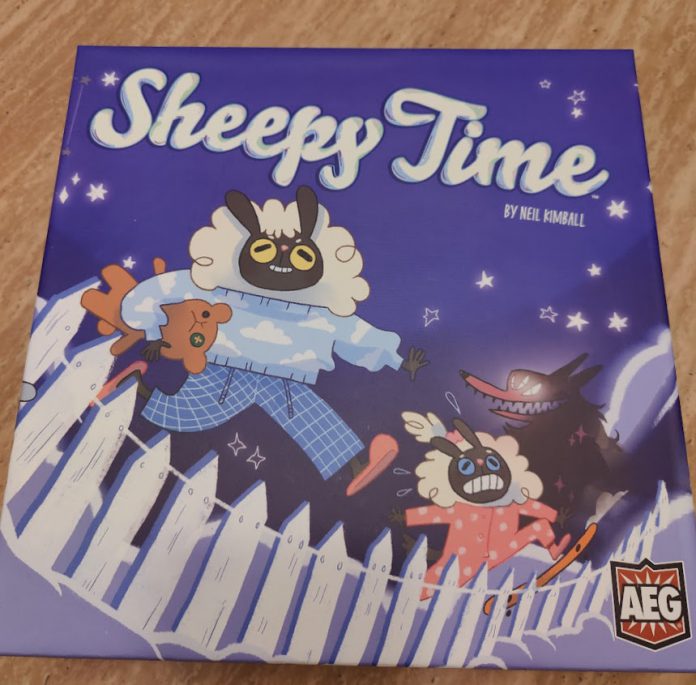Longtime readers of Turn Order may remember a review of a push your luck (PYL) game that I absolutely loved, Long Shot, that involved racing horses around a track and causing complete chaos at the table. Since then, I’ve found myself enjoying PYL games with more and more regularity, as they tend to make fun light, fun fare that can be easy to play at variable player counts, especially when the games don’t have a lot of mean take that style interaction. Even my last review of Uno Ultimate sort of veers into PYL if only slightly, but perhaps my current favorite in this category is AEG’s 2021 title Sheepy Time, featuring some of the most adorable in-game art and meeples (Sheeples?) I’ve had the pleasure of moving around a table in sequential order in some time.
Ewe and Me
Sheepy Time plays 1-4, and involves players moving their sheep around a circular board in an attempt to jump over a literal fence to complete a lap and gather points, while trying to evade being caught by the Nightmare. In my experience, I’ve actually found this to be one of those games that plays great at any player count. Since turns go fast, it scales incredibly well from 2-4, leaving little downtime at the table even amongst slower or younger players. The box claims the game can be played in 30-45, and I would say that on our first play at 4 it lasted a little over an hour as we learned, but since then games have stayed pretty well in that estimated time quite nicely, making it a fun little game to play as filler or a few times back to back for a simple evening of PYL fun.
The game says 10 and up, but I think a fairly sharp younger player could likely navigate it well with help reading if that’s a problem, as the game doesn’t have overly complicated mechanics by any means, although some patient explanation may be in order for the scoring phase or some of the dream tile powers.

Gameplay works in a flow of two phases: Racing and Resting. Racing is when the most gameplay takes place, and Resting is a score checking phase. On player turns, they play a card from their hand, resolve the movement or other action on the card, activate any dream tiles if possible, and then turn passes to the next player. When players reach the Fence, they cross it and score 5 Winks, and can then choose to either keep racing, or Call it a Night. Like many PYL games, this is when the risk/reward factor comes into play most readily: calling it a night means your current points are safe from the Nightmare, but also that you are unable to gain more and are out of the game until after all players have made their decisions.
The tension really rises when multiple players are still going and you’ve chosen to rest: did you make the right call? Are you throwing away your lead? Were you a fool to not go one more time, even though the Nightmare scared you once already? These are the moments I love in PYL games, because it all comes down to chance and decision making. In one play, an early Call on a particularly low score somehow still skyrocketed a player to the top, because the next 3 turns involved players flipping Nightmare cards one after the other, soaring the Nightmare across the fence.
Shear Victory
Perhaps my biggest negative for the game though comes in the Resting phase. The scoring mechanisms in the game are a little obtuse at first, and I would be honest in saying that the biggest slowdown to our first game came from resolving this phase. Now that I’ve played it a few times, the basic mechanisms are a two check system: Did anyone reach a position in which their Wink Token passed their Pillow token? No? Then score the round based on the numbers on the card denoting the amount of players in your game. Yes? Then the game ends, and that person wins. There can be multiple ties, but generally in our games one person tended to win either decisively or by the skin of their teeth. Some of our initial confusion comes from a varied set of icons in the rulebook; the game uses a green winking eye for ‘Winks’, but the token for Winks is… a person’s head. Don’t think about it too hard like we did and you’ll probably be fine.

Once that issue is smoothed out though, you’ll find the game goes a lot faster. We initially thought the game was over after a single round, but then upon careful rereading realized that isn’t actually what happens, and that you can generally expect to play at least 2 to 3 Racing Phases in your games, which manages to be a particular sweet spot before the game wears out its welcome. One particularly disastrous game lasted 5 Racing phases, at which point we gave up and just decided to start over. While these may sound like gripes, it really just highlights that this game is best played fast, fun, and loose, and the longer it goes the less return on that investment you’re likely to get. That said, we only ever had one of those nightmare games, so it was probably just the most awful luck possible for every player involved than the natural state of the game.
A fun wrinkle to the game itself are the Dream Tiles, in which players can use an in-game currency (Zs) to activate when they land on them. During Rest phases, players can place their accumulated Zs on various Dream Tiles, banking on the hope to land on those tiles and activate their powers on the following Racing phase. This small mechanic adds a lot of flavor, because there’s never a guarantee a player may actually get to USE their Dream Tile allotments due to the cards they draw and the movements required of them. While one might think that makes them worthless, they can have incredible impacts on play, such as giving you a second chance to become Brave after a Nightmare encounter (restoring a health state, basically), moving beyond your turn’s limits, drawing cards, or even moving ALL players… a devious power that will certainly not make you a lot of friends, if you push people into the Nightmare. Just saying.
Nightmare on Your Street
What I really enjoy about Sheepy Time though is the ability to give the game some variety through the choice of 3 different Nightmares, who basically come in Easy, Moderate, and Difficult variety. Each one has unique mechanics, and mixing up which one you use can result in much more tense and thrilling games, or easier and relaxing ones. Even the Easy Nightmare can surprise you at times, since their actions are based on pulls from the deck at random, so don’t just assume it’s going to be simple to win against the less involved Nightmare!

When players get touched by the Nightmare, they place their Sheeple on it’s side to denote that they’ve been scared once. If they are touched by the Nightmare a second time, that player has Woken Up and can no longer participate in the current round, discard their hand, and most importantly: reset their Wink token to 0. Getting Woken Up has devastating consequences to players, as it should, which really ramps up the PYL element to the game that at first feels very comfy and easygoing. Getting touched by the Nightmare even a single time puts the fear of God into players, frantically looking to get across the Fence before they possibly have the Nightmare bump into them again (or even worse, bumping into it themselves, because if you land on it, you still get scared!). The Sinister Spider, the ‘expert’ Nightmare, really varies the game up quite a lot, and is truly worth giving a try after having a few games under one’s belt.
Since players get a second chance after encountering the Nightmare the first time, I noticed that many players were still often happy to continually push their luck after becoming scared. Some would try and bank Dream Tile powers to extend their lifespans, figuring they could get scared, land there, become Brave, and keep racking up points. What actually tended to happen in play were plans dashed and laughs had as those plans went up in total smoke thanks to the draw of the card and the actions of other players. Since there are very few chances for other players to directly screw over others, it tends to become entirely self-made disaster too: you could have banked all those points, but you just HAD to go for a third lap, right? The natural “I can’t believe I’ve done this” effect of PYL games makes them fun and competitive without having to worry about being mean or cruel; after all, players have no one to blame but themselves!
Fleecing the Competition
Sheepy Time is an adorable and fun game. I love breaking it out for some quick games, and I actually find that the games tend to go faster than those of Long Shot, although they tend to feel less raucous and explosive, so that may be the deciding factor on purchasing either if you’re in the market for a Push Your Luck style game. I really do love the aesthetic of Sheepy Time, though; the art is adorable, giving a lot of charm and flavor to the game, and the little Sheeple tokens are so cute to look at. The board, a pastel blue and white combo with splashes color evoke that dreamy, relaxing, cloudlike atmosphere the game wants. The insert of the box is… great, sort of. I really do like that AEG included a bespoke insert for the game, but it only works if you store the game horizontally, because if you turn the box vertical, most of the tokens fall out of their holders and flop around in the box. Not a dealbreaker, and honestly it isn’t even a hard thing to clean up, but it is a little frustrating if you tend to store your games standing up.

If you slept on Sheepy Time or are just now coming around to hearing about it and are in the market for a fun and relaxing Push Your Luck game, there is a lot to love in this charming box at an incredibly affordable price, generally hovering around 20 dollars or less; in a market where many entry level board games are retailing for 40 dollars or more, that makes Sheepy Time an even better sell in my opinion; I’ve certainly gotten my money’s worth out of this game, and plan to keep it in my collection for quite a while longer. So fluff up those pillows, get comfy with some cocoa, put on some relaxing music, and then yell at yourself for not resting a turn ago when the Nightmare makes you lose 20 points. You’ll have a great time.


